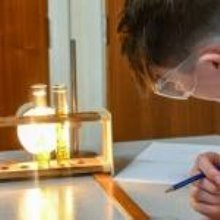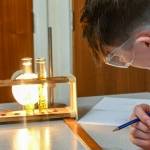
On Monday, Upper Sixth students conducted an experiment to investigate the effect of light intensity on photosynthesis. In a darkened room, an LED bulb was placed at different distances from a test tube filled with water and pondweed. Also in the test tube was sodium hydrogen carbonate which supplies carbon dioxide for the pondweed to photosynthesize, producing bubbles of oxygen.
After the pondweed acclimatised itself to the light, the students then counted how many bubbles were produced and, as the bulb crept closer and closer, more bubbles were seen, signifying light intensity is inversely proportional to distance. As the bubbles increased or decreased depending on the distance, students were able to determine the rate of photosynthesis and calculate the average. One team also had access to a datalogger and were also able to directly measure the oxygen saturation inside the test tubes.
The lesson was an interesting insight into the complexity of photosynthesis and enabled our students to understand how manipulating the independent variable (distance) will have an impact on the dependant variable (number of bubbles) and comprehend the factors affecting photosynthesis.


























